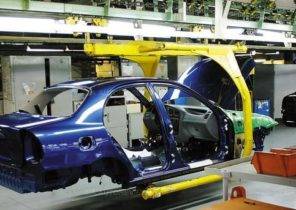Although the coronavirus and the resulting economic crisis caused a very serious impact and become a blow to the stability in the world there are other events. Consider an interesting project of an Estonian company Milrem Robotics in cooperation with the Swedish branch of Sinrob Technologies AB and other European defence companies.
He was introduced as “the most modern in the world of robotic combat unit”. We are talking about light tracked armored vehicles with hybrid engines, which can perform a number of tasks on the battlefield: fire support, artillery, engineering, air defense…
The project is based on already existing ground-based drones of the same enterprise THeMIS. He is in fully functional condition, but has a much more modest size. Its tasks are reduced to the role of light transport and providing fire support to troops on the front. The main interest of such a robotic machine that it may be easier and cheaper manned armored vehicles with comparable capabilities (no need for protected compartment for people, and the training of the crew and the payment of his salary). Besides, she knows no fear, and it is much easier to donate.
Project Type-X RCV receives financial support from the European Commission in the framework of the program-a precursor of the European defence Fund. It is worth noting that the Americans and the Chinese are already actively working in this direction, whereas the us military budget is different colossal dimensions, and Chinese is growing, despite the coronavirus. The Europeans also have reason to be interested, especially because of their defense investment is significantly less.
In addition, there is at least one European country, which works actively in this direction.
“After our success with THeMIS, which provides logistical support to infantry units, we thought about how to provide support to mechanized groups. We had an idea on how to provide support for tanks and armored personnel carriers on the results of conversations with potential customers. One of them — I can’t call him — expressed some interest, which allowed us to launch a real development program two years ago,” says President Milrem Robotics Kuldar Vaarsi. I wonder who was this mysterious client…
In any case, from a European point of view, the development of such a project looks like a rational decision given the deterioration in the strategic plan. The same can be said about the US position in terms of preserving defense spending while their reorientation to the far East: don’t they need to protect their Empire from a new superpower? For the Chinese, this step also seems justified: is such an economically strong country does not need a proper army? All this, of course, raises the question of where all this will lead us…
Military robotics
THeMIS and Type-X RCV are not robots in the literal sense of the word. In the first case we are talking about the tank, which is controlled by a human operator and has its own intelligence. In a way, this radio-controlled military arm. The second car, as reported, should be managed at the same time artificial intelligence and operator, and possess “a set of smart features”, which should ensure its autonomy.
Thus, in the field of on-Board intelligence, the situation is changing. Type-X RCV is not easy to have significant capabilities in this area (intermediate between a manipulator and a real robot and not operated exclusively human-drone): it will be enough just to upgrade to further expand these opportunities. You can install more powerful processors and advanced without touching the engine, the hull design tracks and weapons. All this will significantly reduce costs. Given that the army usually kept in service with armored vehicles in over 30 years, what level of intelligence and autonomy will be of the upgraded Type-X RCV 2-3 decades (or even earlier)?
Some applications of military robotics limited energy autonomy. So walking robot Boston Dynamics, of course, impressive, but hardly suited to combat, because they can not be both invisible and have a large autonomy. You have to choose one or the other: either they are running on battery power and can not last more than an hour or they set to hear the engine. The us Marines have lost interest in these robots, when it became clear that solutions to problems are seen.
As you can guess, are close to the enemy group of soldiers is absolutely not interested in the fact that it was accompanied by a buzzing, like a lawn mower, car. Today there is nothing yet to replace conventional infantry: the reason that not even human intelligence, and capabilities of the human body, which may provide a covert movement within ten hours.
At the same time, armored vehicles with the crew as much noise, and a person has no in this respect any advantage. On the contrary: unmanned equipment is smaller since it does not require the crew quarters. Thus, robotics:
— cheaper because it has a smaller at equivalent power,
— cheaper to maintain, since it does not require frequent use for training soldiers.
— noticeable because of the size,
— potentially has a faster reaction (depending on CPU),
— can be used for a wider range of operations, including suicide.
What can stop her from eventually replace manned vehicles?
Only, at the same time cultural and political factors: our unwillingness to give the car the right to open fire, to take the initiative to kill. That is our fear of the machine-killers.
Will last if this ban? It is not excluded. Some of the prohibitions are violated only in exceptional cases: for example, cannibalism remains a rarity even in times of famine. Whatever it was, accurate to say anything is impossible. The only way to assess the strength of the ban is to consider the situation when there is a persistent desire to break it, but nothing happened.
Nevertheless, the situation should soon become clearer. And if the ban falls, part of the armed forces (except infantry) may be replaced by robots.
Human infantry and robotic armor
How would the world look like, in which the whole of the combat units consisted solely of robots (of course, with the support of engineers and technical staff to ensure development, production and maintenance)? Hard to say, but I can imagine three things:
1. This may enhance the advantage of the most advanced in the technical plan of the parties: having a robotic army is the superiority of which consists exclusively of the people of the armed forces. All this, of course, does not negate the fact that the infantry will be needed to hold the cities, and what occupation to win the hearts of the people. This will mean strengthening of the existing trends, in which the military superiority of the developed world allows to conduct operations on any area where there is no nuclear umbrella (Iraq in 2003, Afghanistan in 2001), but does not negate his complete powerlessness during the occupation and counter-insurgent forces.
2. The desire to escape from a protracted situation through a more rigorous application of force can get reinforcements. Obstinate city really can be “better” (significantly) increasing the degree of violence. That is how the Americans conquered Fallujah in 2004, and the Russians — Ivan in 2000, the Israelis “calm” Gaza, and the Syrians returned to Aleppo. To prevent the use of such tactics can political factors, the rejection of the mass death of civilians, i.e. war crimes. But robots don’t care, and to deal with the city much easier can artillery and armored vehicles, lots of infantry is not needed. If the infantry is not directly involved in the operation, armored vehicles composed of robots, and the technical staff is too far to look at the face of the civilian population, a psychological barrier to extreme violence against the civilian population may fall.
3. A dictatorial regime can do without a close guard or, rather, the part which engaged in bloody repression. Its role can play engineers and technicians, people who do not look to violence in the face. When the Chinese government killed several thousand people during the uprising in Tiananmen square in 1989, and the Uzbek authorities destroyed over thousands of demonstrators in Andijan in 2005, in the course were ordinary soldiers and tanks. Their reluctance to fire on unarmed citizens managed to overcome one way or another. The classic way to achieve this goal in a dictatorship — the formation of close guard, which is incomparable (ideological, ethnic, religious) loyalty to government and is ready to use force against fellow citizens. Robots, by definition, obedient and ruthless. To disperse the demonstration using light armored vehicles with automatic weapons will be much easier. In this case, the technique of human service personnel again will not look the victims in the face, which will reduce the psychological barrier to violence.
“It’s amazing to observe how professionals from Örnsköldsvik and Tallinn to work together and complement each other, creating something so innovative,” says Kuldar Vaarsi.
All of this will be the day after tomorrow. Which will come faster than we think. There is still time to Americans, Chinese, Europeans, Russians and other agreed norms of behavior or even banning certain forms of military robots, since a certain level of autonomy. After all, we (minus North Korea) have reached an agreement on the prohibition of chemical weapons, which as a whole is still enforced (albeit imperfectly).
The delay is in any case not worth it.







